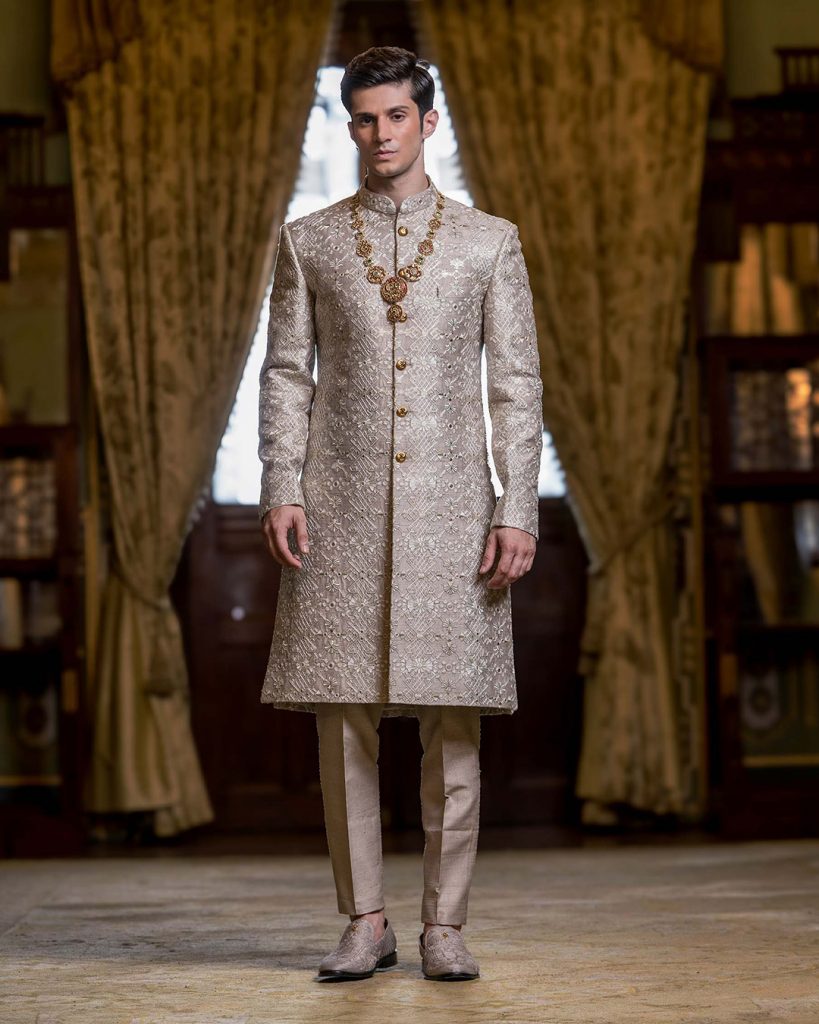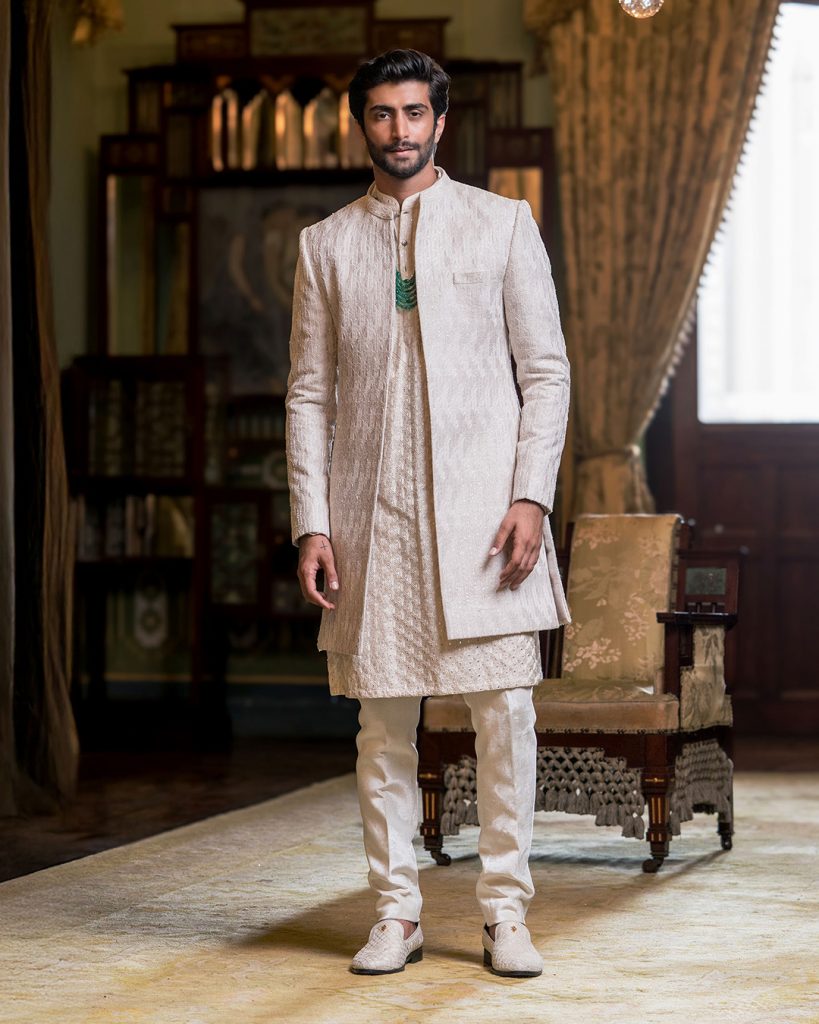The sherwani and the achkan are two of the most beloved traditional menswear options for Indian men. Whether it is a wedding ceremony, a festive gathering or a traditional themed formal event, both these garments are on the top of the list. Now, both of them may look similar, but they are completely different in terms of the fabric options, silhouettes, and suitable occasions.
What is the difference between an achkan and a sherwani, and how do you determine which one is more suitable for you? Well, there are several factors to consider when picking your ideal option. In this blog, we will explore:
What is an Achkan?

History and Origin
The origin of the Achkan dates back to the late Mughal era and evolved as a courtly garment worn by aristocrats, nobles and courtiers. The original design of the achkan was inspired by Persian coats, ‘chogha’ and ‘qaba’, and the Indian traditional wrap garment, angrakha (long coats with side fastenings or buttons). The garment later evolved to become a popular choice among men for ceremonial wear, such as weddings and festive occasions.
Design
The achkan is a long coat, featuring a tapered silhouette that ends right above or at the knees, offering a form-fitting, slim appearance. Some designs may flare out below the waist, depending on regional style.
Modern-day achkans feature central button closures, often adorned with decorative buttons made of metal, fabric-covered wood or gemstones. The achkan usually features a structured bandhgala or a standing collar, also known as the Nehru collar, that sits closely around the neck.
Fabric and Colours
Achkans are usually tailored from sophisticated fabrics, such as silk, brocade, and cotton-silk blends. Compared to sherwanis, achkans usually feature minimal embellishments but are sometimes embroidered, especially for wedding occasions and other celebratory events.
There is no restriction when it comes to the colour choice. It truly depends on your personal preference, theme and time of the event. From vibrant hues to pastel colours, achkans can be explored in a plethora of shades.
What is a Sherwani?

History and Origin
The traditional attire finds its origin in the courts of the Mughals, where royals and nobles dressed in similar, long, flowing coats. In the 19th century, during the British rule, sherwanis evolved from achkans, incorporating European tailoring techniques. The sherwani was later formalised as a court dress worn at state events and colonial meetings.
In the early 20th century, the sherwani became popular among wealthy landowners, rulers, and the Indian aristocracy. The elaborate outfit projected refinement, dignity and modernity while celebrating traditional roots. However, with the evolution of fashion, it became a preferred choice for weddings and other celebratory occasions across various communities.
Design
The sherwani is a stylised, formal attire worn by men on special occasions, such as weddings. It is a similar-looking garment to the achkan, but unlike an achkan, this one is slightly longer, falling below the knees or calf length. Wedding sherwanis may sometimes feature a slight flare starting below the waist, adding to their grandeur and regality.
The sherwani features a structured silhouette and a front opening with a row of buttons, either exposed or under a concealed placket. It is often referred to as a “bandhgala”, as it features a short stand collar, often embroidered and embellished as per the sherwani’s design.
Fabric and Colour
The fabric and colour choices are the decisive factors that determine the sherwani’s formality, seasonal appropriateness and aesthetic appeal. Sherwanis are often tailored from luxurious fabrics such as silk, brocade, velvet, jamawar, and cotton-silk blends to achieve an appropriately elegant and sophisticated look.
Traditional colours such as beige, ivory and maroon are always the preferred choice for weddings. However, modern grooms today are experimenting with a wider colour palette for their wedding and engagement sherwanis. Pastel hues such as mint green, peach, powder blue, and butter yellow have taken centre stage, especially for daytime events.
Key Differences between Achkan and Sherwani
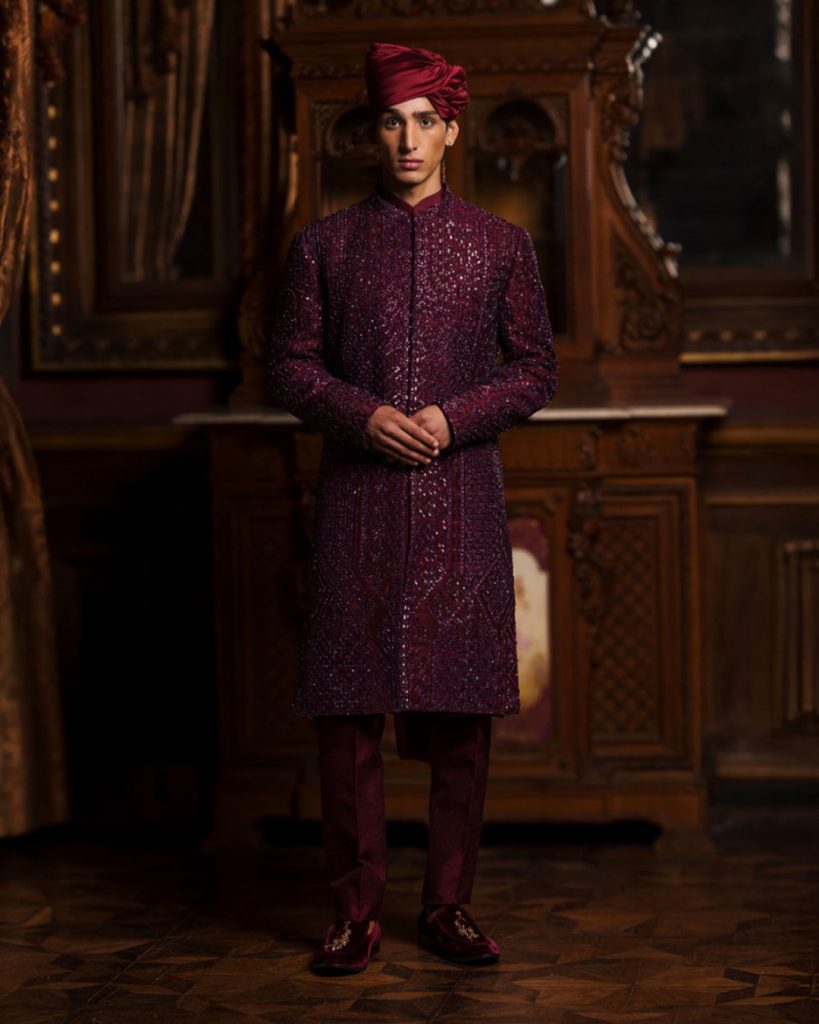
Some of the key differences between sherwani and achkan are:
Origin: The origin of the achkan is believed to have occurred during the Rajput/Mughal era. The sherwani, however, became popular during the Mughal/British era.
Length: Achkans usually end right above the knee or over it, while sherwanis sit below your knee and may even reach calf-length.
Fit: Achkans usually feature a slim and tailored fit. Sherwanis, on the other hand, are structured and voluminous, with a pronounced flare.
Occasions: Achkans are more suitable for semi-formal occasions and festive gatherings. Sherwanis are preferred for elaborate occasions such as weddings and pre-wedding ceremonies.
Fabric Choice: Achkans are made from lightweight fabrics, such as silk, brocade, and cotton-silk blends, to achieve an understated look. Sherwanis are tailored using regal-looking fabrics, such as silk, brocade and jamawar, featuring heavy embroidery and embellishments.
Achkan vs Sherwani: Styling Tips
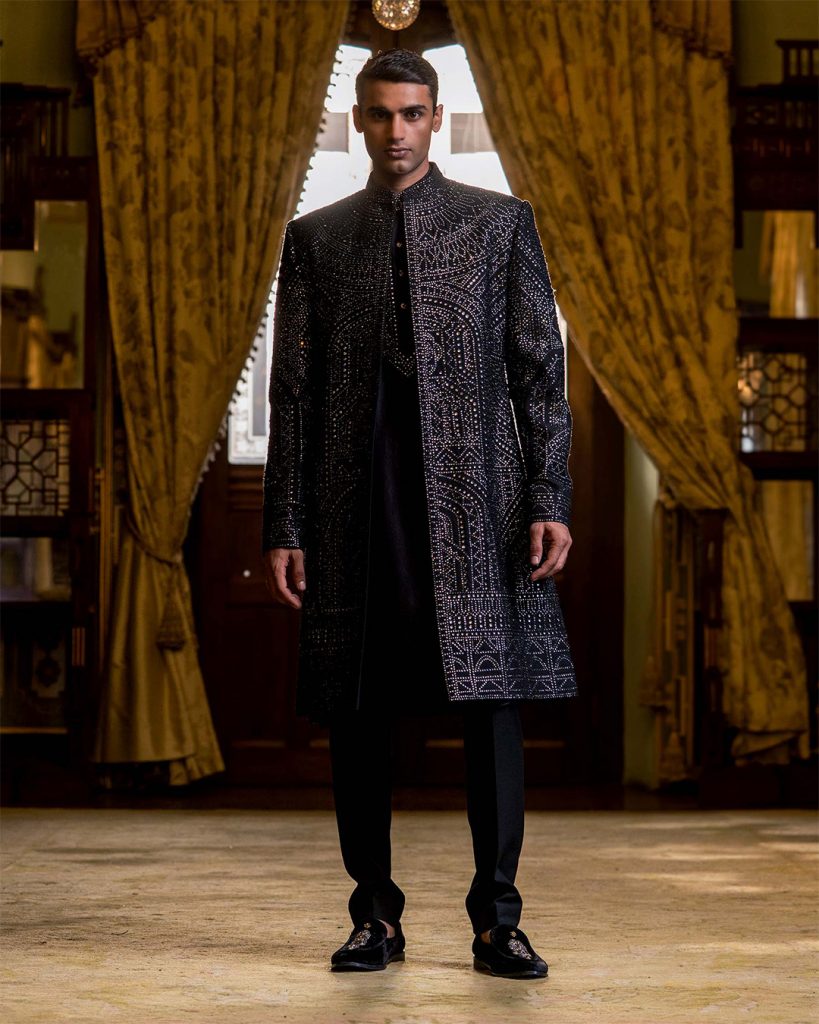
Styling Tips for Achkan
The right type of styling can elevate your achkan look a few notches:
- Pick a suitable bottom, as it will significantly define your overall look. You can pick from a churidar, straight pants or trousers, salwar or a dhoti to create the ideal look.
- Accessorise as per your style to give your outfit a personal touch. Pocket squares, dupattas, brooches or pins, matching footwear and watches are all essentials when wearing an achkan.
- The fit and tailoring of the achkan play a pivotal role. It should be tailored well and should fall just below the knee or at the mid-calf.
- Pick the right fabric and embroidery to achieve your desired look. Achkans usually feature lighter fabrics and tone-on-tone embroidery for an understated look.
- Choose a colour based on the theme, fashion preferences and the time of the occasion. Lighter colours are more suitable for daytime events, while deeper, darker hues will look better for night-time functions.
Styling Tips for Sherwani
Make your sherwani look stand out with these effective styling tips:
- Start with a sherwani that fits you seamlessly. An ill-fitted sherwani can make you look shabby and unkempt.
- Experiment with different silhouettes. Layered sherwanis, open-front sherwanis and anarkali sherwanis are some lesser-explored options but are sure to make you stand out and make a style statement.
- Pair your reception sherwani with contrasting bottoms for a striking look. You can also experiment with different types of bottoms to make your sherwani look stand out.
- Style your perfect engagement sherwani with suitable accessories to create a balanced look. If you are wearing an elaborate sherwani design, keep the accessories minimal with just a watch, dupatta and safa. For a subtle sherwani design, add a necklace, a shawl, rings and a brooch to add depth and character.
- Traditional footwear is more suitable to pair with sherwanis. However, you can also opt for semi-formal sandals and loafers if you want to add a modern touch to your look.
Achkan vs Sherwani: Which one should you choose?
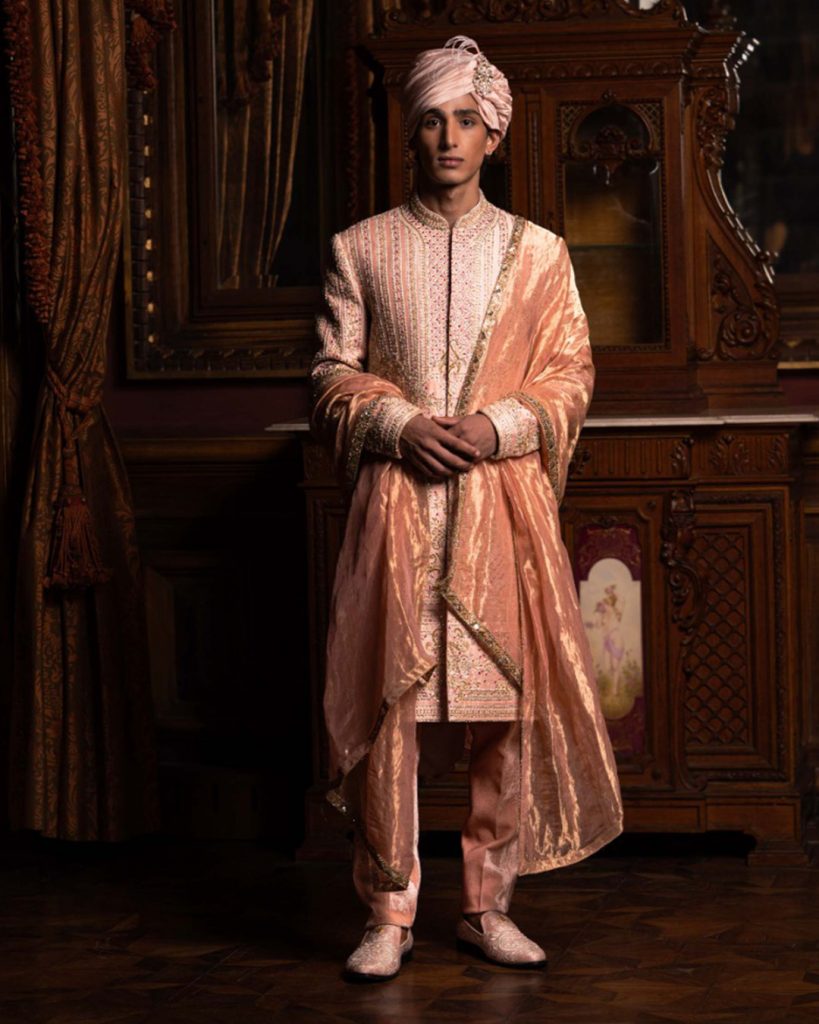
Considering all the differences between sherwani, the simple answer to sherwani vs achkan is, whatever suits your requirements. Both achkans and sherwanis serve different purposes, and the one you pick truly depends on your preference. Achkans are more suitable for low-key events, while sherwanis offer a more opulent look for elaborate occasions such as weddings.
Final thoughts: Achkan or Sherwani?
Pick an achkan if:
- You are attending a formal event or want to look polished as a wedding guest.
- If you are getting married or want simple attire for your engagement ceremony.
- If you want to achieve a minimalistic and contemporary look.
- If you prioritise comfort over looks.
Pick a sherwani if:
- If you are getting married, then a sherwani is the perfect wedding attire.
- If you love wearing statement pieces.
- If you want to embrace your traditional culture and explore Indian craftsmanship.
- If you want to stand out with your sartorial choices.
Frequently Asked Questions
Is an achkan the same as a sherwani?
Though not the same, the achkan and sherwani are pretty similar. Sherwani evolved from achkan, and thus the similarity. Achkans are a simpler garment, best suited for formal events and pre-wedding events. Sherwanis, however, are an elaborate rendition of the achkan and are worn mostly by grooms as their wedding attire.
Can I wear an achkan for my wedding?
If you are hosting an intimate wedding ceremony with a few guests or a simple court wedding, then an achkan is the perfect wedding attire for you.
Which is more comfortable: an achkan or a sherwani?
Both the achkan and the sherwani are fairly comfortable to wear if you get them tailored to fit you seamlessly. If you want to wear something lightweight, then you can choose an achkan. For an elaborate setting, a sherwani will be more suitable.
Are there regional variations of Achkans or Sherwanis?
Yes, there are regional variations to both achkans and sherwanis. Some of the regional variations of ‘achkan’ are ‘daura’, popular in the northeast; ‘angi’ from southern India; and ‘chola’ from the Himalayan region.
The most popular styles of regional sherwanis include Lucknowi sherwani, Hyderabadi sherwani, Jodhpuri sherwani, Rajasthani sherwani and Rajputi sherwani.
What footwear goes best with each?
Both semi-formal and traditional footwear will pair well with achkans. Jootis, kolhapuris, brogues or oxfords, traditional sandals, formal slip-ons and loafers will suit most occasions. For sherwanis, traditional jootis, Kolhapuris, leather shoes, velvet shoes, and embellished sandals are most preferred.
What are some other traditional wear choices for men?
If an achkan or sherwani is too elaborate for you, you can also explore bandi sets. These are simpler in terms of design and feel much lighter to wear. You can explore different bandi styles, such as an engagement bandi or a wedding bandi, to create a simple yet impactful look.
